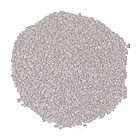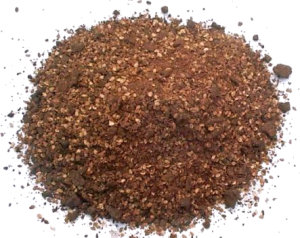
Complete organic fertilizer
 Last week, I discussed how micronutrient
deficiencies in our soil make even homegrown vegetables less nutritious
than they were a few decades ago. Steve Solomon's
solution to this problem is to enrich his soil with what he calls
"complete organic fertilizer." Gardening
When It Counts gives
you some leeway in blending this fertilizer, but the gist of the recipe
is as follows:
Last week, I discussed how micronutrient
deficiencies in our soil make even homegrown vegetables less nutritious
than they were a few decades ago. Steve Solomon's
solution to this problem is to enrich his soil with what he calls
"complete organic fertilizer." Gardening
When It Counts gives
you some leeway in blending this fertilizer, but the gist of the recipe
is as follows:
- 4 parts seedmeal
- 1 part lime. (The best mixture is a quarter agricultural lime, a quarter gypsum, and half dolomite lime. If you're only using one type, dolomite is best because it includes both calcium and magnesium.)
- 1 part finely ground rock phosphate, bonemeal, or high-phosphate guano
- 0.5 to 1 part kelpmeal or 1 part basalt dust
 The recipe is mixed by volume
and results in a fertilizer with NPK of
5:5:1, along with substantial amounts of the most important
micronutrients. Solomon says that not only does complete organic
fertilizer result in balanced nutrient levels in the soil, it is also
easy for beginning gardeners to deal with and doesn't require hauling
so much bulk to your farm.
The recipe is mixed by volume
and results in a fertilizer with NPK of
5:5:1, along with substantial amounts of the most important
micronutrients. Solomon says that not only does complete organic
fertilizer result in balanced nutrient levels in the soil, it is also
easy for beginning gardeners to deal with and doesn't require hauling
so much bulk to your farm.
I was leery of the price
tag attached to Solomon's mixture, but he says
that the ingredients are relatively cheap when purchased at feed
stores. He spends about $300 per year buying
the components, and gets $4,000 to $8,000 worth of vegetables in
return. Solomon uses a gallon to a gallon and a half of his
complete organic
fertilizer on every 100 square feet of garden, then adds the same
amount again as side-dressing on his higher demand vegetables.
This fertilizer is in addition to a quarter inch coating of compost
added to the garden each year.
Before you all rush out
to buy seedmeal, here are some potential disadvantages of complete
organic fertilizer:
- The price tag is still considerably higher than buying enough compost to reach the same fertility level.
- Complete organic fertilizer doesn't add much organic matter, which is a definite problem if you have a clayey garden like mine.
- Lime should be used with care when gardening over limestone, the
way we are. Your soil will probably already be somewhat alkaline
and may be very high in calcium and magnesium. Do a soil
test before adding any lime!
All of those warnings
aside, I suspect some of you might like to give
complete organic fertilizer a shot. If you do, please check back
and let me know how your experiment went!
This post is part of our Gardening When It Counts lunchtime series.
Read all of the entries:
|
Want more in-depth information? Browse through our books.
Or explore more posts by date or by subject.
About us: Anna Hess and Mark Hamilton spent over a decade living self-sufficiently in the mountains of Virginia before moving north to start over from scratch in the foothills of Ohio. They've experimented with permaculture, no-till gardening, trailersteading, home-based microbusinesses and much more, writing about their adventures in both blogs and books.
Want to be notified when new comments are posted on this page? Click on the RSS button after you add a comment to subscribe to the comment feed, or simply check the box beside "email replies to me" while writing your comment.

I'm really glad you posted about that, because I'd completely forgotten how I'd been reading over the last year or so that rock phosphate supplies were perhaps running out. (My memory of the article I read is vague.) That would explain the high prices, and would make Solomon's complete organic fertilizer unsustainable.
Maybe a better option would be to plant some dynamic accumulators --- they can concentrate phosphate from deep in the ground that other plants can't access. Some dynamic accumulators of phosphorus include buckwheat, carroway, German chamomile, common chickweed, clovers, dandelions, docks, garlic, lamb's quarter, lemon balm, lupine, marigold, meadowsweet, mustard, redroot pigweed, purslane, savory, sorrel, vetch, watercress, and yarrow. Probably the easiest to grow would be patch of buckwheat, but I know what we have plenty of those around as weeds mixed into our lawn, that then end up as mulch on our beds.
Good point! Although some plants are good at accumulating nutrients even from the surface soil --- there's usually plenty of everything a plant would need in the soil, but it's often bound tightly to soil particles and hard for most plants to get at.
Actually, fungi are often the best at pulling those nutrients out of the soil and sharing with plants, although I don't know if they specifically work with phosphorus.